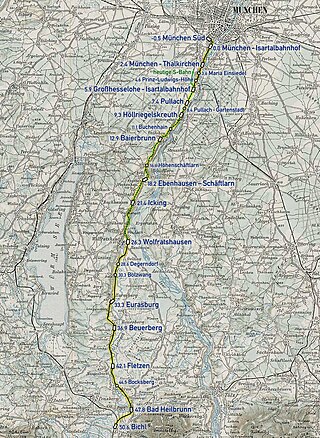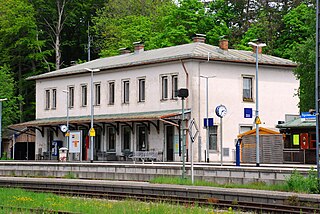
Holzkirchen is a market town in Bavaria, Germany. With a population of over 16,000 (2008) it is the largest town in the Miesbach district.

The Munich S-Bahn is an electric rail transit system in Munich, Germany. "S-Bahn" is the German abbreviation for Stadtschnellbahn, and the Munich S-Bahn exhibits characteristics of both rapid transit and commuter rail systems.
Transdev Germany is the largest private operator of passenger buses and trains in Germany. It is a subsidiary of Transdev.

München Hauptbahnhof or Munich Central Station is the main railway station in the city of Munich, Germany. It is one of the three stations with long-distance services in Munich, the others being Munich East station and Munich-Pasing station (München-Pasing). München Hauptbahnhof sees about 450,000 passengers a day, which puts it on par with other large stations in Germany, such as Hamburg Hauptbahnhof and Frankfurt (Main) Hauptbahnhof. It is classified by Deutsche Bahn as a category 1 station, one of 21 in Germany and two in Munich, the other being München Ost. The mainline station is a terminal station with 32 platforms. The subterranean S-Bahn with 2 platforms and U-Bahn stations with 6 platforms are through stations.

Munich-Pasing is a railway station in the west of Munich. It is the third-largest station in the city, after München Hauptbahnhof and München Ost.

The S3 is a service on the Munich S-Bahn network. It is operated by DB Regio Bayern. It runs from Mammendorf station to Holzkirchen station via Pasing, central Munich, Munich East, Giesing and Deisenhofen. Trains reverse in Munich East station and, in order for S-Bahn services from St Martinstraße to be inserted into the S-Bahn line while simultaneously reversing to run into the S-Bahn tunnel under central Munich or vice versa, the line between Munich East station and the flying junction between München-Giesing and Fasangarten stations is one of the few in Germany that has traffic running on the left.

Line S7 is a line on the Munich S-Bahn network. It is operated by DB Regio Bayern. It runs from Wolfratshausen via Höllriegelskreuth, central Munich, Höhenkirchen-Siegertsbrunn and Aying to Kreuzstraße. Trains reverse in Munich East station and, in order for S-Bahn services from St.-Martin-Straße to be inserted into the S-Bahn line while simultaneously reversing to run into the S-Bahn tunnel under central Munich or vice versa, the line between Munich East station and the flying junction between München-Giesing and Fasangarten stations is one of the few in Germany that has traffic running on the left.

Munich Donnersbergerbrücke station is a station with four platform tracks in the Schwanthalerhöhe district of the Bavarian state capital of Munich and a hub of the Munich S-Bahn. Here line S 7 separates towards Wolfratshausen from the S-Bahn trunk line. It is also served by services of the Bayerische Oberlandbahn on the Munich–Holzkirchen railway on the S-Bahn trunk line. The station is located east of the Donnersberger Bridge.

Deisenhofen is a Munich S-Bahn railway station in Deisenhofen, a district of Oberhaching.

Großhesselohe Isartalbahn station is a station on the Isar Valley Railway from Munich to Bichl in the German state of Bavaria. Since 1981, it has been a station of the Munich S-Bahn. The station is located in the municipality of Pullach, which also contains the stations of Pullach and Höllriegelskreuth. It is classified by Deutsche Bahn as a category 5 station and has two platform tracks. The station building is registered as a historic building on the List of Bavarian Monuments.

The Mangfall Valley Railway is a single-tracked, electrified railway that runs through the Mangfall valley in Bavaria, Germany, between Holzkirchen and Rosenheim. It is exclusively used by regional services. However it also acts as a diversionary line in case of difficulties on the Munich–Rosenheim railway.

The Munich–Rosenheim railway is a 65 kilometre-long double-track main line of the German railways. It connects Munich Hauptbahnhof with Rosenheim station, where it connects with the Rosenheim–Salzburg railway, which connects with the line to Vienna at Salzburg, and the line to Kufstein, which continues to Innsbruck and the Brenner line to Italy. The line is part of the "Main line for Europe", connecting Paris with Bratislava and Budapest and the almost identical line 17 of Trans-European Transport Networks (TEN-T). It is part of the line 1 of TEN-T. It is electrified at 15 kV, 16.7 Hz. It was opened between Munich and Rosenheim in 1871.
The Munich–Holzkirchen railway is a continuously-electrified, double-track, railway in the German state of Bavaria. It runs from Munich to Holzkirchen via Deisenhofen.

The Isar River Valley Railway is a standard gauge and electrified railway in the German state of Bavaria. Originally it was 51.1 km long, running from Munich South station to Bichl and was built from 1891 to 1898 in sections by the Lokalbahn AG company (LAG). The section from Munich South to Wolfratshausen was classified as a main line, while the section from Wolfratshausen to Bichl was classified as a branch line. In 1900, the LAG electrified the section from the Isartalbahnhof to Höllriegelskreuth for suburban services at 580 volts DC. In 1938, the LAG and, with it, the Isar Valley Railway were nationalised. After the Second World War, Deutsche Bundesbahn converted the electrification to 15 kV AC ; this was completed in 1955 and extended to Wolfratshausen in 1960. The northern section from Munich South to Grosshesselohe Isartal station and the southern section from Wolfratshausen to Bichl was closed by Deutsche Bundesbahn between 1959 and 1972. The middle section is now used by line S 7 of the Munich S-Bahn. The name of the line refers to the Isar as the northern half of the line follows the river's western bank. On the other hand, the southern section is located in the valley of the Loisach.

Wolfratshausen station is a station of the Munich S-Bahn. It is located in the Upper Bavarian town of Wolfratshausen in Germany. It is classified by Deutsche Bahn as a category 6 station. It has two platform tracks next to a central platform. The station is located in the network area of the Münchner Verkehrs- und Tarifverbund and is served by line 7 of the S-Bahn, which is operated by Deutsche Bahn.

On 9 February 2016, two Meridian-branded passenger trains collided head-on at Bad Aibling, Germany. Of approximately 150 people on board the two trains, 12 people died and 85 others were injured, 24 critically.

Meridian was a commuter rail service that operated between 2013 and 2020 in Bavaria, Germany operated by the railway company Bayerische Oberlandbahn (BOB), owned by Transdev.

Holzkirchen station is a railway station on the Munich S-Bahn in the district of Holzkirchen in Upper Bavaria, Germany. It is served by the S-Bahn line S3 and Bayerische Regiobahn.

The Integral is a diesel multiple unit (DMU) train type operated by Regiobahn GmbH on commuter services in North Rhine-Westphalia. Between 1998 and 2020, they were operated by the Bayerische Oberlandbahn on regional services between Munich, Bayrischzell, Lenggries and Tegernsee. They were built by the now defunct Jenbacher Werke.

The Schaftlach station is the railway station of Schaftlach and the only railway station in the municipality of Waakirchen in the district of Miesbach in Upper Bavaria. It is located on the Holzkirchen-Lenggries railway line, which opened in 1874, and has been a junction station since 1883, when the privately operated Schaftlach-Tegernsee railway went into service.






















